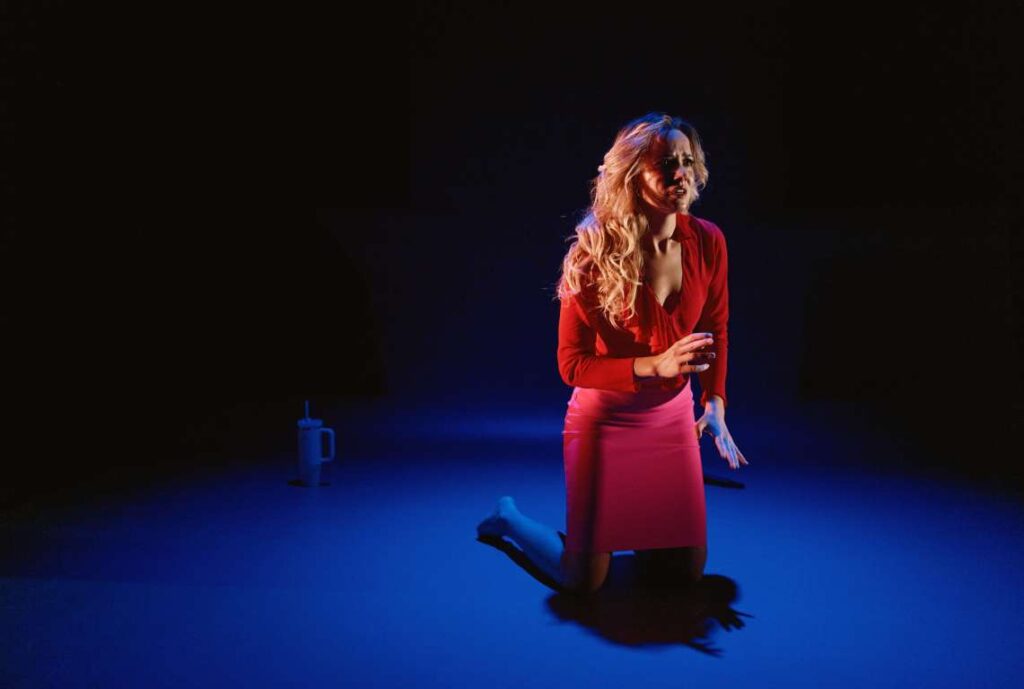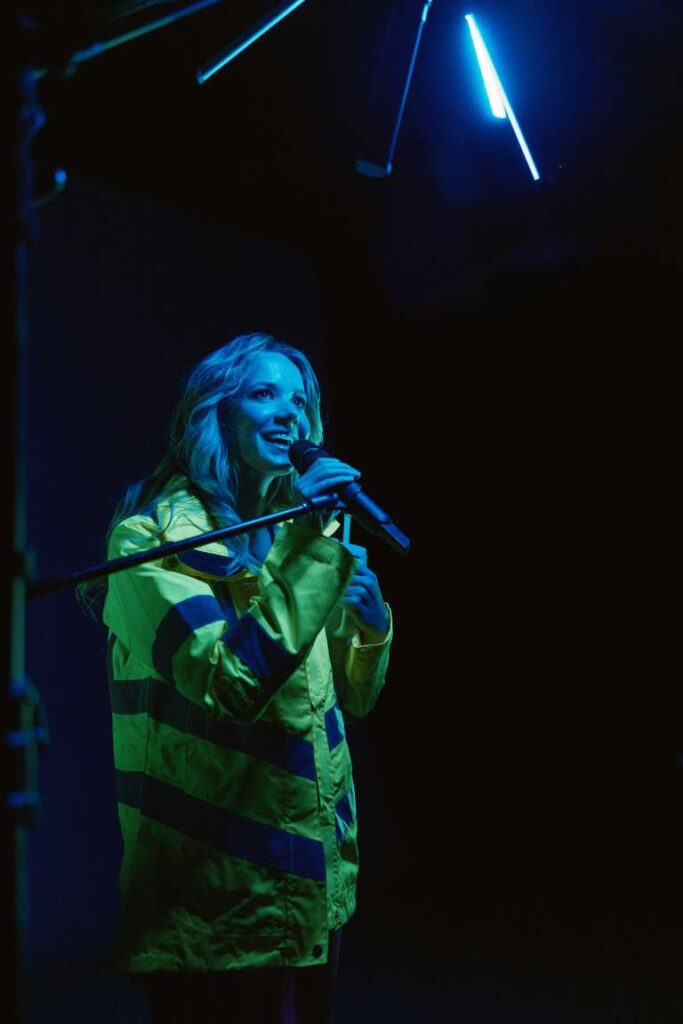By Stuart Miller…
Julia McDermott generates heat in Brian Watkin’s one-woman show about a woman falling apart… and a planet doing the same.
Stacey, the title character in “Weather Girl,” has long excelled at maintaining the facade: she matches her perky blonde looks with tight, but not too tight clothes, and the unceasing chirpiness demanded of local news.
“I’m the happy voice next to the calming coffee ad next to the loud kids cereal commercial,” she tells us. “I am your Good Morning. I am your Rise and Shine.”
But the cracks are not just starting to show, they’re rupturing loudly, like tectonic plates about to shift, wrecking everything in sight. On the personal front, years of hurt, from the abandonment by her drug-addicted mother, left her empty inside, a hole she has filled with a steady diet of alcohol– that’s not water she totes around in her travel mug, but Prosecco, sipped or gulped before and after each cheery on-air segment.


Her job is hollowing her out also. In California, our slow rolling climate catastrophe is now accelerating with scorching temperatures fueling destructive and deadly wildfires and every time Stacey suppresses her true feelings to paste on a smile for her viewers, she feels like she has killed off another piece of herself.
“I’m a fluffer, I’m a hype man, I’m a used car salesman selling a world we can’t even have,” she finally confesses.
With “Weather Girl,” Brian Watkins has written a riveting and intriguing one-woman play drawing parallels between the brewing trouble stemming from how Stacey has desperately paved over her own problems and America’s mindless self-destruction in the face of scientific facts.

And for just over an hour, Julia McDermott is compelling as this woman on the verge of a breakdown who eventually tries to break free with her own Howard Beale “Network” moment. (Only no one can open their windows and yell in Stacey’s world because the air quality is growing increasingly dangerous as the wildfires encroach.)
Prowling and pacing, staggering and stumbling on the mostly bare stage, Stacey earns laughs– some nervous, some shocked– as she leads us through her collapse: from the moment she learns about the people who died in the house that was her backdrop as she chatted on camera about the wildfires, her hurt starts seeping and then pouring out.
When her boss tells her she’s getting promoted, which means shipping off to Phoenix (the hottest, driest place imaginable), she tells him off, only to have him jovially dismiss her reaction–even after she shares that she’s drinking on the job. All that matters are her ratings and the money she brings in for the corporate parents. When the wealthy tech bro she has almost passively agreed to date, shows off his car collection, she takes him for a drunken drive– he’s so careless that when she asks about his expensive car, “Can I wreck it?” the guy, looking to get laid, says yes without thinking about real-life consequences. (We hear all this through McDermott, who also inhabits this guy and the other people Stacey interacts with.) But by that point Stacey is done holding back and puts the pedal down hard.
Along the way she finds her mother in a homeless encampment and, desperate to be recognized and to have her pain acknowledged, follows her, readying herself for a confrontation. Watkins mostly manages to balance on the tightrope between his pointed comedy, heart-rending drama and political commentary. That continues as Stacey’s mom takes her on surprising detours through musical theater and drunken karaoke before the play suddenly veers off into magical realism.
Watkins’ falls short when it overreaches. In the opening moments he tries too hard, with Stacey saying, “Some guy told me that in the bible sin enters the world at 4am but I never read that or any other part of the bible, but I get it, ya know, cuz you can sometimes like smell evil at 4 am…And at a quarter past four you feel all the destroyed things swimming around in the dark and when you do the weather here in California you can sometimes feel the devil’s breath right at your earlobe.”
But then he quickly finds his rhythm and grounds Stacey in the prosaic, or as mundane as life can be when your soul is cracking and the world around you is burning.
Then comes the magical realism– her mother, the heroin addict, also has a gift, an ability to conjure water. Watkins starts his playwright’s note, “This play is about a miracle, something I’ve been yearning for of late” but the steps the show takes in that direction are muddled. While it adds a complicating element that prevents the story from being too on the nose, it doesn’t add enough to the ideas driving the play to justify its presence.
Ironically, a “Ta-da” crowd-pleasing moment at the end undercuts any ambiguity about whether the magic was real or part of Stacey’s snapping. But his ideas around this magic lack clarity thematically.
Watkins created the sci-fi Western “Outer Range” for TV, which was also well-written but similarly struggled to toggle between realism and the unexplainable. “Weather Girl” was produced by Francesca Moody, who was also behind “Fleabag” and “Baby Reindeer;” so it’s not surprising that “Weather Girl” has been optioned for a series by Netflix. Perhaps Watkins can better flesh out those water magic ideas for the series.
Even if he can’t, most of his writing and McDermott’s all-in, well-modulated emotional roller-caster of a performance make “Weather Girl” a brisk and intense reminder about the dangers of denial, personally and politically.
“Weather Girl” runs about 70 minutes at St. Ann’s Warehouse through October 12th.
Photos by Emilio Madrid


